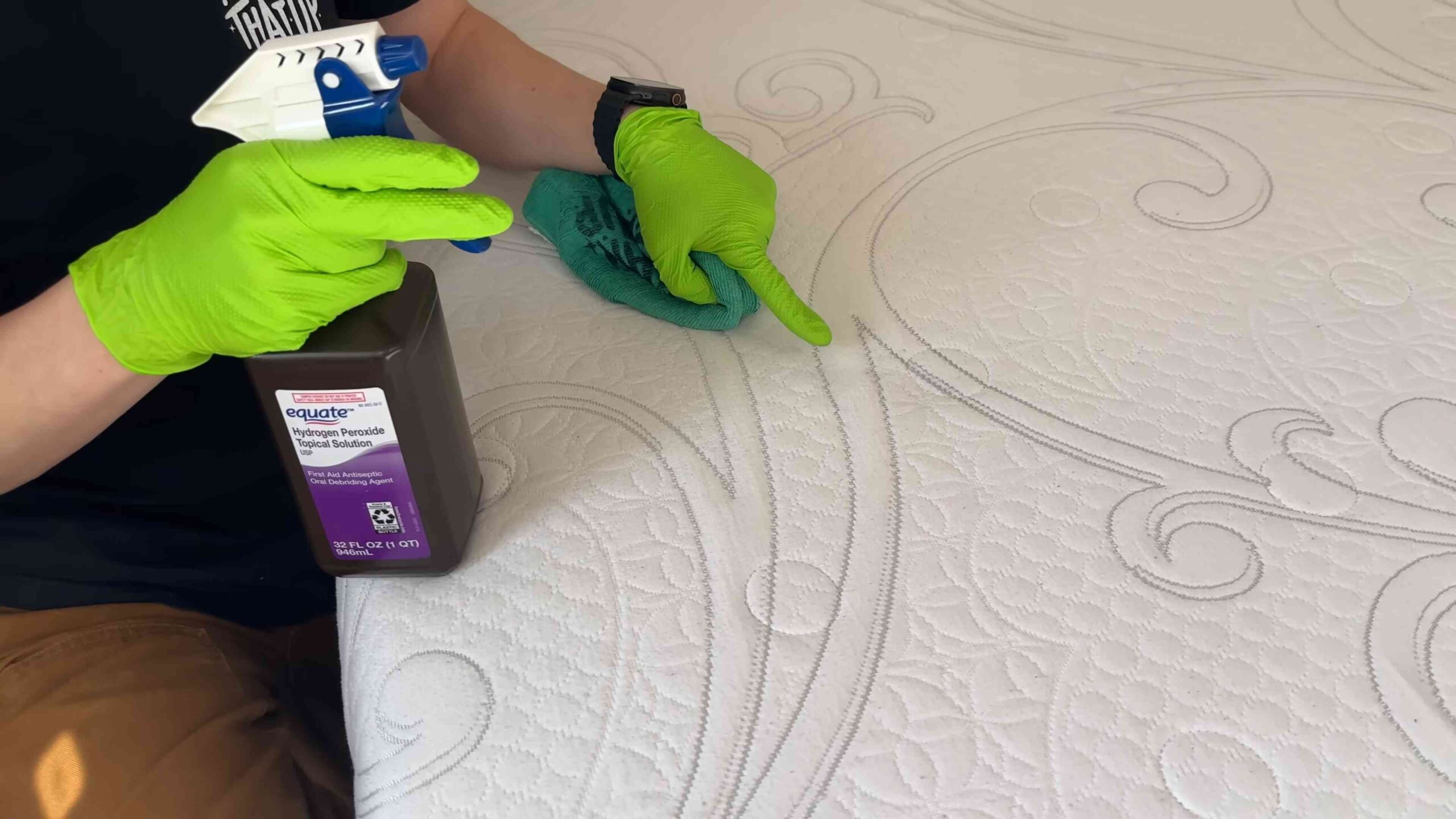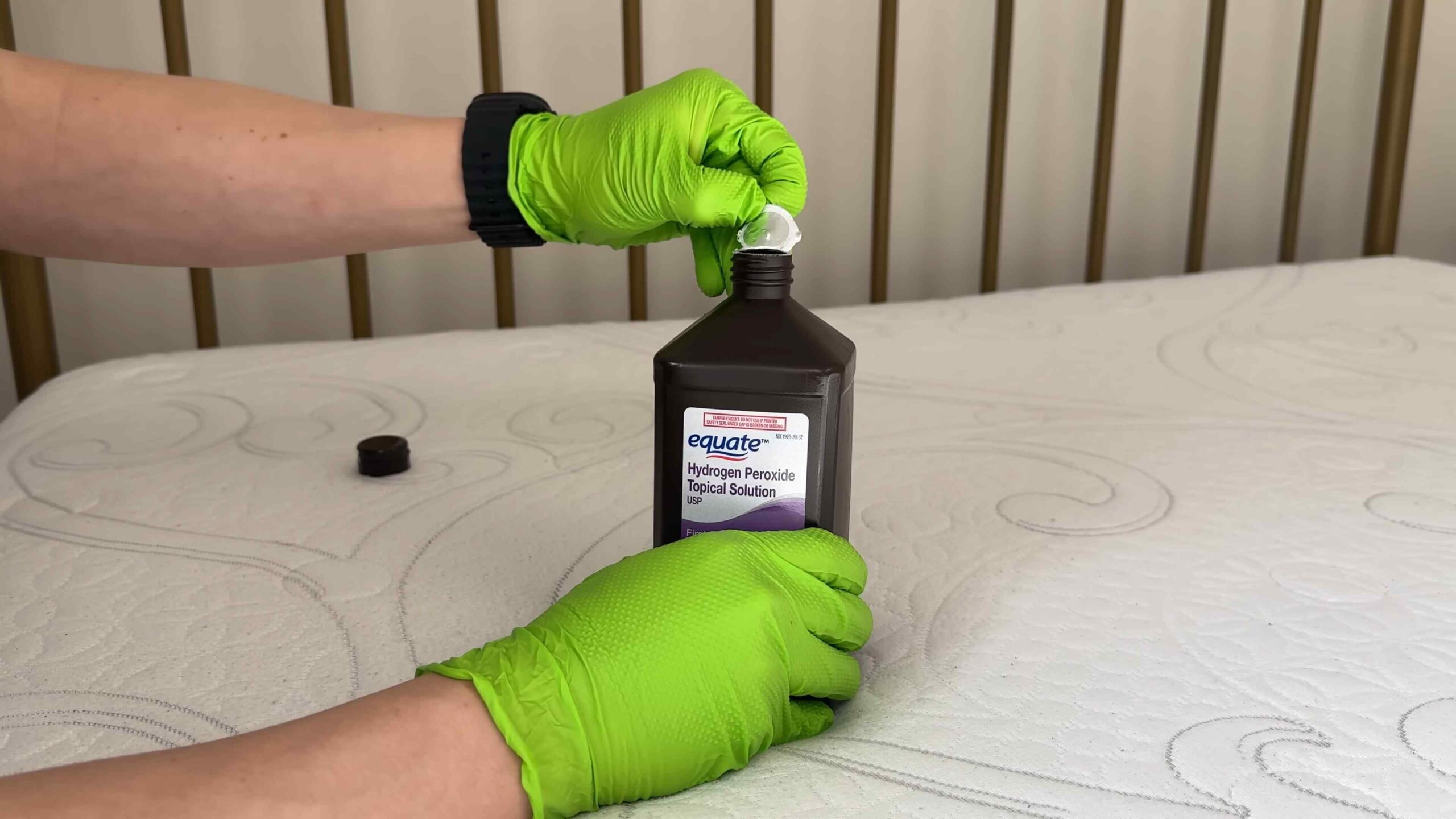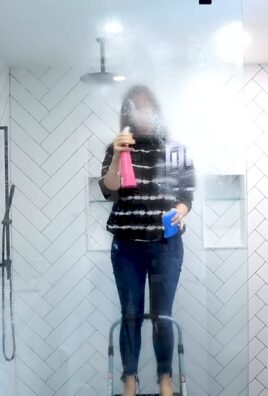Clean mattress hydrogen peroxide – sounds like a science experiment, right? Well, it’s actually your secret weapon to a fresher, healthier sleep! Let’s face it, our mattresses are silent sufferers. They absorb sweat, spills, dust mites, and all sorts of unseen nasties. While we might diligently wash our sheets, the mattress itself often gets neglected. But fear not, because I’m here to share a simple, effective, and surprisingly affordable DIY trick using hydrogen peroxide to revitalize your mattress.
Mattress cleaning, while not always top-of-mind, has a long history. In the past, people relied on airing out mattresses in the sun and beating them to remove dust. While those methods still have merit, they don’t tackle stains or deep-seated allergens. That’s where our modern solution comes in. Using clean mattress hydrogen peroxide is a game-changer because it’s a natural disinfectant and bleaching agent. It’s effective against bacteria, mold, and mildew, all common culprits behind unpleasant odors and potential health issues.
Why do you need this DIY trick? Because a clean mattress isn’t just about aesthetics; it’s about your well-being. A cleaner sleep environment can improve your sleep quality, reduce allergy symptoms, and even boost your overall mood. Plus, professionally cleaning a mattress can be expensive. This DIY method allows you to achieve similar results for a fraction of the cost. So, let’s dive in and learn how to use hydrogen peroxide to give your mattress the deep clean it deserves!

DIY Mattress Cleaning: Banishing Stains and Refreshing Your Sleep Sanctuary
Okay, let’s be honest, mattresses are magnets for all sorts of… well, let’s just call them “life events.” Spills, sweat, maybe even the occasional midnight snack crumb – it all ends up there. And while we might diligently wash our sheets, the mattress itself often gets neglected. But fear not! I’m going to walk you through a simple, effective, and budget-friendly way to clean your mattress using the power of hydrogen peroxide. Get ready to say goodbye to stains and hello to a fresher, cleaner sleep!
What You’ll Need
Before we dive in, let’s gather our supplies. This is a pretty straightforward process, so you probably already have most of these items on hand.
* **Hydrogen Peroxide (3% solution):** This is your stain-fighting hero! Make sure it’s the standard 3% solution you find at the drugstore. Higher concentrations can damage your mattress.
* **Spray Bottle:** A clean, empty spray bottle is essential for even application.
* **Baking Soda:** This acts as a natural deodorizer and helps absorb moisture.
* **Dish Soap (Optional):** For tougher stains, a tiny bit of mild dish soap can boost the cleaning power.
* **Essential Oil (Optional):** A few drops of your favorite essential oil (like lavender or eucalyptus) can add a pleasant, fresh scent.
* **Clean Cloths or Sponges:** You’ll need these for blotting and wiping. Microfiber cloths work great!
* **Vacuum Cleaner with Upholstery Attachment:** This is crucial for removing baking soda and any lingering debris.
* **Rubber Gloves:** To protect your hands, especially if you’re using dish soap.
* **Fan or Open Windows:** To help speed up the drying process.
Preparing Your Mattress for Cleaning
Before you start spraying and scrubbing, it’s important to prep your mattress. This will ensure a more effective cleaning process.
1. **Strip the Bed:** Remove all bedding, including sheets, blankets, pillowcases, and mattress protectors. Wash them according to their care instructions. This is a great opportunity to give your entire sleep setup a refresh!
2. **Vacuum the Mattress:** Use the upholstery attachment on your vacuum cleaner to thoroughly vacuum the entire surface of the mattress. Pay special attention to seams, crevices, and any areas with visible dirt or debris. This step removes loose particles and prepares the surface for cleaning.
3. **Identify Stains:** Take a good look at your mattress and identify any specific stains you want to target. Knowing what you’re dealing with will help you adjust your cleaning approach.
Tackling Stains with Hydrogen Peroxide
Now for the main event! This is where the hydrogen peroxide magic happens.
1. **Prepare Your Cleaning Solution:** In your spray bottle, combine hydrogen peroxide with a few drops of dish soap (if using) and a few drops of essential oil (if using). I usually go for about 1 cup of hydrogen peroxide, 2-3 drops of dish soap, and 5-6 drops of essential oil. Don’t overdo it with the dish soap, as it can be difficult to rinse out.
2. **Test in an Inconspicuous Area:** Before spraying the entire mattress, test the solution in a small, hidden area (like the underside of the mattress) to ensure it doesn’t cause any discoloration or damage. Wait for the area to dry completely before proceeding.
3. **Spray the Stained Areas:** Lightly spray the stained areas with the hydrogen peroxide solution. Don’t saturate the mattress; a light mist is all you need.
4. **Blot, Don’t Rub:** Use a clean cloth or sponge to gently blot the stained areas. Avoid rubbing, as this can spread the stain and damage the mattress fibers. Work from the outside of the stain inwards to prevent it from spreading.
5. **Let it Sit:** Allow the hydrogen peroxide solution to sit on the stains for about 5-10 minutes. This gives it time to break down the stain.
6. **Blot Again:** After the waiting period, blot the stained areas again with a clean, dry cloth to remove any excess moisture.
7. **Repeat if Necessary:** For stubborn stains, you may need to repeat the spraying and blotting process a few times. Be patient and persistent!
Deodorizing and Drying Your Mattress
Once you’ve tackled the stains, it’s time to deodorize and dry your mattress. This is where the baking soda comes in.
1. **Sprinkle Baking Soda:** Generously sprinkle baking soda over the entire surface of the mattress. Don’t be shy! The baking soda will absorb any remaining moisture and odors.
2. **Let it Sit (for a Long Time!):** This is the most important part of the deodorizing process. Allow the baking soda to sit on the mattress for at least 4-6 hours, or even overnight if possible. The longer it sits, the more effective it will be.
3. **Vacuum Thoroughly:** After the waiting period, use your vacuum cleaner with the upholstery attachment to thoroughly vacuum up all the baking soda. Make sure to get into all the seams and crevices. You may need to go over the mattress several times to remove all the baking soda.
4. **Air Dry:** Allow the mattress to air dry completely. Open windows and use a fan to circulate air and speed up the drying process. Make sure the mattress is completely dry before putting your bedding back on. This is crucial to prevent mold and mildew growth.
Dealing with Specific Types of Stains
While the hydrogen peroxide method is effective for many types of stains, here are some tips for dealing with specific challenges:
* **Blood Stains:** Act quickly! Blot the stain with cold water and then apply the hydrogen peroxide solution.
* **Urine Stains:** Blot up as much urine as possible with paper towels before applying the hydrogen peroxide solution. You may need to repeat the process several times. An enzymatic cleaner designed for pet stains can also be helpful.
* **Sweat Stains:** The hydrogen peroxide and baking soda combination should work well for sweat stains.
* **Food and Drink Stains:** Blot up any spills immediately and then apply the hydrogen peroxide solution.
Preventing Future Stains
Of course, the best way to deal with stains is to prevent them from happening in the first place! Here are a few tips:
* **Use a Mattress Protector:** A waterproof mattress protector is your best defense against spills, stains, and allergens.
* **Avoid Eating and Drinking in Bed:** I know, it’s tempting, but it’s also a recipe for disaster.
* **Wash Your Sheets Regularly:** This helps prevent the buildup of dirt, sweat, and allergens on your mattress.
* **Flip or Rotate Your Mattress Regularly:** This helps distribute wear and tear evenly and can prolong the life of your mattress.
Important Considerations
* **Always test your cleaning solution in an inconspicuous area first.** This is crucial to prevent any damage or discoloration to your mattress.
* **Don’t saturate your mattress with liquid.** Too much moisture can lead to mold and mildew growth.
* **Allow your mattress to dry completely before putting your bedding back on.** This is essential to prevent mold and mildew.
* **If you have a very delicate or expensive mattress, consider consulting a professional cleaning service.**
Final Thoughts
Cleaning your mattress with hydrogen peroxide is a simple, affordable, and effective way to remove stains, deodorize, and refresh your sleep sanctuary. By following these steps, you can enjoy a cleaner, healthier, and more comfortable sleep environment. Happy cleaning!

Conclusion
So, there you have it! This simple, yet incredibly effective, DIY trick using hydrogen peroxide to clean your mattress is a game-changer for anyone seeking a fresher, healthier sleep environment. Forget expensive professional cleaning services or harsh chemicals. This method is not only budget-friendly but also utilizes a readily available and relatively safe ingredient.
Why is this a must-try? Because a clean mattress is more than just aesthetically pleasing; it’s crucial for your overall well-being. Dust mites, allergens, and lingering odors can significantly impact your sleep quality and even trigger allergies or respiratory issues. This DIY solution tackles these problems head-on, leaving you with a mattress that feels revitalized and ready for a good night’s rest.
Beyond the basic method, there’s room for customization. For instance, if you’re dealing with particularly stubborn stains, consider pre-treating them with a paste of baking soda and hydrogen peroxide before applying the general spray. You can also add a few drops of your favorite essential oil, like lavender or eucalyptus, to the hydrogen peroxide solution for an extra boost of freshness and aromatherapy benefits. Just be sure to test the essential oil mixture on an inconspicuous area of the mattress first to ensure it doesn’t cause any discoloration. Another variation involves using a UV light after the hydrogen peroxide treatment to further sanitize the mattress and kill any remaining bacteria or mold spores. This is especially useful if you live in a humid environment.
Don’t just take our word for it, though. We wholeheartedly encourage you to try this DIY mattress cleaning trick yourself. The process is straightforward, the ingredients are easily accessible, and the results are truly remarkable. Imagine sinking into a bed that smells clean, feels fresh, and is free from allergens and dust mites. That’s the power of this simple solution.
We’re confident that you’ll be amazed by the difference this makes. Once you’ve given it a try, we’d love to hear about your experience! Share your before-and-after photos, tips, and any variations you experimented with in the comments section below. Your feedback will not only help other readers but also contribute to a community of individuals dedicated to creating healthier and happier homes. So go ahead, give your mattress the TLC it deserves and experience the joy of sleeping on a truly clean and refreshed surface. You won’t regret it!
Frequently Asked Questions (FAQs)
1. Is hydrogen peroxide safe to use on my mattress?
Yes, hydrogen peroxide is generally safe to use on mattresses when used correctly. The standard 3% solution available in most stores is diluted enough to be effective without causing significant damage to most mattress materials. However, it’s always crucial to test the solution on a small, inconspicuous area of the mattress first to ensure it doesn’t cause any discoloration or damage. Avoid using higher concentrations of hydrogen peroxide, as they can bleach or weaken the fabric. Also, ensure the mattress is thoroughly dried after treatment to prevent mold growth. If you have a memory foam mattress, be extra cautious and use a very light application of the hydrogen peroxide solution, as excessive moisture can damage the foam.
2. What type of mattress is this DIY cleaning method suitable for?
This DIY cleaning method is generally suitable for most types of mattresses, including innerspring, memory foam, latex, and hybrid mattresses. However, as mentioned earlier, it’s essential to exercise caution when cleaning memory foam mattresses, as they are more susceptible to moisture damage. For latex mattresses, avoid using excessive amounts of hydrogen peroxide, as it can potentially degrade the latex over time. Always test the solution on a small, hidden area first, regardless of the mattress type. If you have a particularly delicate or antique mattress, it’s best to consult with a professional cleaning service before attempting any DIY cleaning methods.
3. How often should I clean my mattress using this method?
The frequency of cleaning your mattress depends on several factors, including your lifestyle, allergies, and whether you have pets. As a general guideline, it’s recommended to clean your mattress at least twice a year. However, if you have allergies or pets, or if you sweat heavily during sleep, you may want to clean your mattress more frequently, such as every three months. Regular vacuuming of the mattress is also essential to remove dust mites and allergens between deep cleanings. Using a mattress protector can also help to keep your mattress clean and extend its lifespan.
4. What if I don’t have hydrogen peroxide? Are there any alternatives?
While hydrogen peroxide is the star ingredient in this DIY cleaning method, there are a few alternatives you can consider. One option is to use a mixture of white vinegar and water. Vinegar is a natural disinfectant and deodorizer, but it’s important to dilute it properly to avoid a strong vinegar smell. Another alternative is to use a commercial enzyme cleaner specifically designed for mattresses. These cleaners contain enzymes that break down stains and odors. However, be sure to follow the manufacturer’s instructions carefully. Baking soda is also a great option for deodorizing and absorbing moisture. Sprinkle a generous amount of baking soda over the mattress, let it sit for several hours, and then vacuum it up thoroughly.
5. How long does it take for the mattress to dry after cleaning?
The drying time for your mattress will depend on several factors, including the humidity level in your environment, the amount of hydrogen peroxide solution used, and the ventilation in the room. Generally, it can take anywhere from a few hours to a full day for the mattress to dry completely. To speed up the drying process, you can use a fan to circulate air around the mattress or open windows to improve ventilation. Avoid using a hairdryer or other heat source to dry the mattress, as this can damage the materials. Ensure the mattress is completely dry before putting on clean sheets to prevent mold growth.
6. Can this method remove old or stubborn stains?
While this DIY method is effective for removing many types of stains, old or stubborn stains may require additional treatment. For tough stains, consider pre-treating them with a paste of baking soda and hydrogen peroxide. Apply the paste to the stain, let it sit for several hours, and then blot it with a clean cloth. You can also try using a commercial stain remover specifically designed for mattresses. Be sure to follow the manufacturer’s instructions carefully and test the product on a small, inconspicuous area first. For particularly stubborn stains, you may need to repeat the cleaning process several times. If the stain persists, it’s best to consult with a professional cleaning service.
7. Will this method eliminate dust mites?
Yes, this method can help to eliminate dust mites from your mattress. Hydrogen peroxide is a natural disinfectant that can kill dust mites and their eggs. However, it’s important to note that dust mites are microscopic creatures, and it’s impossible to completely eliminate them from your home. Regular cleaning of your mattress, bedding, and carpets is essential to control dust mite populations. Using a mattress protector and washing your bedding in hot water can also help to reduce dust mite allergens. Vacuuming your mattress regularly with a HEPA filter vacuum cleaner is also highly recommended.
8. Is there a specific type of hydrogen peroxide I should use?
You should use standard 3% hydrogen peroxide, which is readily available at most drugstores and supermarkets. Avoid using higher concentrations of hydrogen peroxide, as they can bleach or damage your mattress. The 3% solution is diluted enough to be effective without causing significant harm to most mattress materials. Always test the solution on a small, inconspicuous area of the mattress first to ensure it doesn’t cause any discoloration or damage.
9. What if my mattress has a strong odor? Will this method help?
Yes, this method can help to eliminate strong odors from your mattress. Hydrogen peroxide is a natural deodorizer that can neutralize many types of odors, including those caused by sweat, urine, and mildew. The baking soda in the pre-treatment paste also helps to absorb odors. For particularly strong odors, you may need to repeat the cleaning process several times. You can also add a few drops of your favorite essential oil, like lavender or eucalyptus, to the hydrogen peroxide solution for an extra boost of freshness. Be sure to test the essential oil mixture on an inconspicuous area of the mattress first to ensure it doesn’t cause any discoloration.
10. Can I use this method on a wet mattress (e.g., after a child wets the bed)?
Yes, you can use this method on a wet mattress, but it’s important to address the wetness first. Blot up as much of the liquid as possible with clean towels. Then, sprinkle a generous amount of baking soda over the wet area to absorb any remaining moisture. Let the baking soda sit for several hours, or even overnight, and then vacuum it up thoroughly. Once the mattress is dry, you can proceed with the hydrogen peroxide cleaning method. This will help to disinfect the mattress and eliminate any lingering odors. Consider using a waterproof mattress protector to prevent future accidents from damaging your mattress.





Leave a Comment